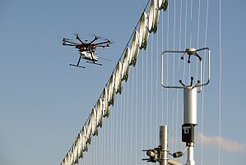Measuring carbon dioxide with drones – new prospects for climate research

Octocopter measuring carbon dioxide (Photo: Martin Kunz)
Dr. Jost V. Lavric and Martin Kunz of the Max Planck Institute for Biogeochemistry in Jena (Germany) participated in the ScaleX campaign with ‘COCAP’, a carbon dioxide analyzer weighing only 1 kg that they specifically developed for unmanned aerial vehicles. In cooperation with Prof. Dr. Richard Grant and Evan Flatt of Purdue University (West Lafayette, USA), COCAP was mounted on an octocopter to analyze the spatiotemporal atmospheric carbon dioxide distribution. Combining these measurements with meteorological data enables the scientists to calculate the night-time carbon dioxide emissions of soil and vegetation.
Unmanned aerial vehicles equipped with lightweight and precise measurement devices for greenhouse gases have the potential to become an important tool for the investigation of climate-relevant interactions between biosphere, geosphere, and atmosphere. The data obtained during ScaleX will help pushing forward this approach and validating it with independent methods.
Contact:
Dr. Jost V. Lavric
jost.lavric@bgc-jena.mpg.de
Tel. 3641 57 63 68
Martin Kunz
mkunz@bgc-jena.mpg.de
Tel. 3641 57 63 14
